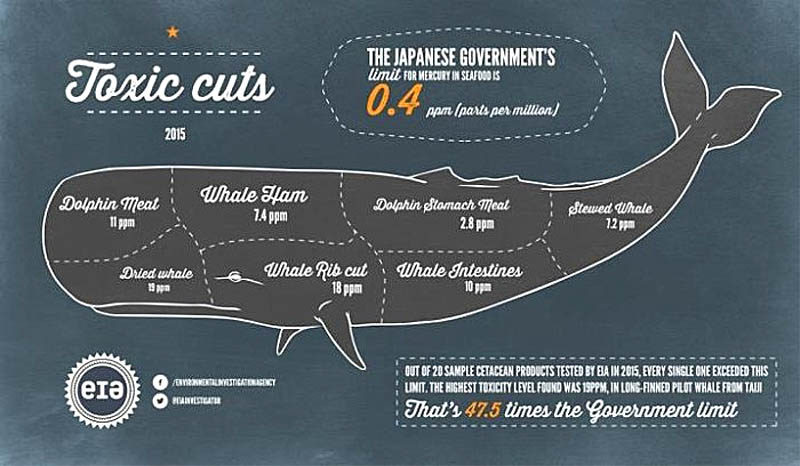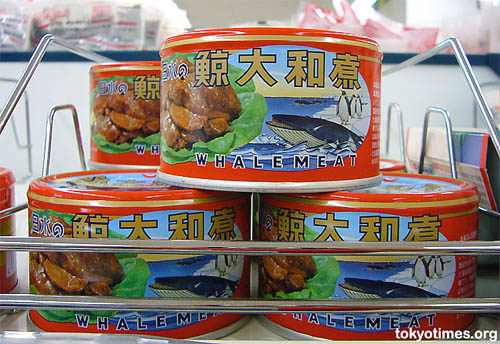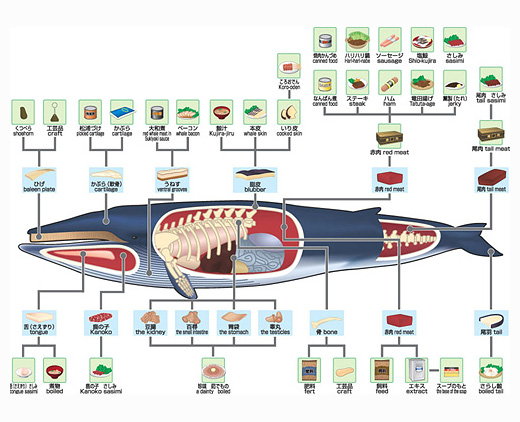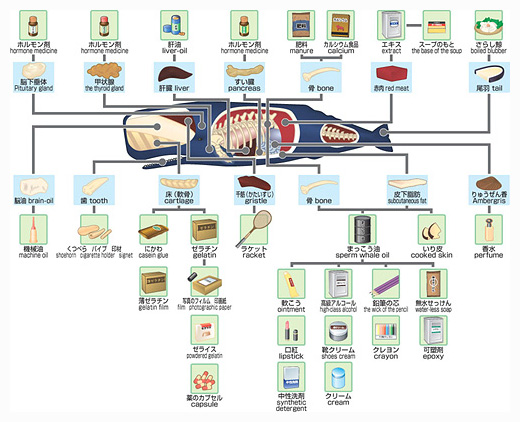Consumer Health Risk from Whale Products
If you haven't already been exposed to toxic whale products you probably will unless governments take
action.
Introduction
It's only in recent years that we are beginning to realise how much we have polluted the oceans with, amongst
numerous other things, toxic chemicals. Since whales can live from between 20 to 200 years, these toxins can
accumulate in dangerously high concentrations for both whales and humans.
Human health issues from consuming whale products including premature birth, reduced birth weight, neurological
damage and respiratory diseases in children, immunodeficiency, kidney diseases, Parkinson’s disease,
arteriosclerosis, and high blood pressure in adults. Inuit's in Canada, Alaska and Greenland are particularly
affected, but also parts of the populations of Japan and the Danish Faroe Islands.
Virtually every part of a whale can be exploited and marketed for use and consumption by unsuspecting consumers.
Typically in food, cosmetics, pharmaceuticals and health products. Indirect use of whale products into the food
chain can be from whale derived animal and fish feed. Whale derived fertilizer can be used for crop and cereal
cultivation.

Image credit: Environmental Investigation Agency
Tested Japanese cetacean products exceed government's toxisity limit for mercury
Background
Whales are full of toxins. Over a number of decades, an abundance of scientific evidence has been gathered on the toxic
chemicals in whale products and related diseases in children and adults. The whaling nations Japan, Norway and
Iceland know that whale products are toxic but continue to ignore medical recommendations and guidelines and flout
what little legislation exists. The following provides just some of this information:

Credit: Tokyo Times
Whale meat from 'scientific research' sold in
From 1987, Japan hunted and killed 16,323 whales for 'scientific research'. After all this research it must be well known by the
Japanese authorities that whale products are heavily polluted with toxic chemicals. DNA
analysis of whale meat sold in Japan has also been conducted by foreign researchers and conservation
organisations since 1993.
New Scientist reported on 6 June 2002 that tests on whale liver samples revealed levels of mercury 5000 times higher
than the Japanese government’s limit. The research carried out by the University of Hokkaido stated that "Acute
intoxication could result from a single ingestion". The study found that mercury levels detected in kidneys and
lungs were approximately 100 times higher than the limit.
The researchers warned that pregnant women risk poisoning their unborn children. In the 1950s and early 1960s,
hundreds of children around Japan’s Minamata Bay were born with horrific birth defects after their mothers
ate seafood contaminated with mercury compounds. Thousands more suffered brain damage due to Minimata disease.
A Greenpeace investigation revealed allegations from an informant that cancerous tumours found in whales
are cut out and the remaining meat processed for public sale. Download
the full dossier.
Whale products have mercury, PCB and DDT levels exceeding the thresholds of safe human consumption. Stockpiles of
this toxic whale meat have accumulated as a bi-product from the Japanese ‘Scientific Research’ whaling. In an effort
to reduce the stockpiles, the Institute of Cetacean Research reintroduced whale meat to school menus and sold it for
a third of the market price.
From 2010, according to a government survey, 5,355 primary and middle schools nationwide (18 percent of Japan's
primary and middle schools) served whale meat in school lunches, with schools in Wakayama and Nagasaki prefecture
serving it as a way to teach children about traditional foods.
In June 2014, CNN reported that 'Japan begins whaling season with meat feast for school children.
In 2015, Environmental Investigation Agency (EIA) reported that whale meat shipped from Norway to Japan contained levels of harmful pesticides that
violate human health standards established by the Japanese Government, The Norwegian whale meat was too toxic, even
for the Japanese health authorities and was rejected.
Documents revealed that the rejected whale meat contained aldrin, dieldrin, and chlordane,
thought to play a role in causing birth defects, neurological harm, and some cancers if humans consume them in high
quantities.
“Japan is right to take action to prevent the import of toxic Norwegian whale meat,” said Clare Perry, head of
EIA’s Oceans Campaign. “However, it should also look to its own cetacean hunts, which provide thousands of tonnes of
toxic whale and dolphin products for unsuspecting Japanese consumers, putting them at increased risk of serious
diseases, including Parkinson’s disease, arteriosclerosis and diabetes.”
Selling this product to unsuspecting consumers not only reduces the whale meat stockpiles but the profits gained
are used to fund ‘research’ for the next years whale hunt and onwards.
Database of scientific publications on toxic substances in whale meat
OceanCare and Pro Wildlife have made all relevant studies and papers on cetacean meat and contaminant load
available to the public. At www.toxic-menu.org. Here,
consumers, politicians and scientists will find important information on studies dealing with whale meat and the
risks of consuming these products.
Whaling ambitions into the 21st century - profit before everything else

Yoshimasa Hayashi - Minister of Agriculture, Forestry and Fisheries
To sustain a declining and heavily subsidised whaling industry, the hunt is not so much for whale meat, but new
whale derived products for highly profitable markets such as: pharmaceuticals, cosmetics, health supplements,
nutraceuticals, animal feeds, food additives, confectionary, lubricants, etc.
As reported in the Japan Times, The plan is to market whale products as health supplements, nutritious drinks, a
potential weapon in the fight against dementia, a way of combating fatigue, a way of reducing health costs.
Kyodo Senpaku Co is already producing dietary supplement products and nutritious drinks using whale-derived
balenine as an ingredient. Kyodo Senpaku is a for-profit company that conducts the collection, processing and
wholesale of whale byproducts on behalf of the Institute of Cetacean Research. Kyodo Senpaku has offices world
wide.
Japan's fisheries minister Yoshimasa Hayashi said on 26 February 2013, "I don't think there will be
any kind of an end for whaling by Japan".
In 2018, the fisheries agency committed $900,000 just for a study into the future of commercial whaling.
New applications for whale products is given in a report by the Whale and Dolphin Conservation Society (WDCS)
entitled 'Reinventing the
Whale'. Amongst its conclusions, the WDCS reports: 'It is clear that Norway, Iceland and Japan are intent
on reinventing the whale for the twenty-first century and will use any hunts permitted by the IWC to continue
developing new industrial uses for whales, including pharmaceuticals, health supplements, animal feed and even
cosmetics. The report was dated May 2010 and much will have moved on since then.
It is known that whale meat is toxic, but what of the other whale products planned for the new markets?
What are the risks to consumers from these products, either directly, or indirectly through animal, poultry and fish
meal? So many questions but no answers.
As has already been demonstrated by the whaling industry, profit comes before the wellbeing of whales or
humans.
The figures below show the direct and indirect human exposure to whale derived products from the hump back whale
and sperm whale. These whales are protected but DNA sampling has shown that their meat has been sold in Japan:

Whale derived products - hump back whale

Whale derived products - sperm whale
Whale products in every part of the human food chain
Most of us are aware of food manufacturers reluctance to spell out the ingredients in their products. If you
study the charts above you will see that whale products can be added to the human food chain either directly, or
indirectly:
Food
- Vegetables, cereals, fruit, bread: Cultivated from whale derived fertilizer. manure.
- Meat, fish: Fed from whale derived animal & fish feed and whale meat.
- Meat products, burgers, sausages, ham, jerky, reconstituted meat foods: Processed from whale
meat.
- Soups, sauce, stock, meat extract: Derived from whale meat.
- Deserts, confectionary, ice cream, dips, yogurt, cakes etc: Gelatin derived from whale
cartilage.
Cosmetics:
- Perfume: Derived from whale ambergris.
- Creams: Derived from whale oil.
- Lipstick: Derived from whale oil.
Pharmaceutical and health products:
- Hormone medicine: Derived from whale pituitary gland, pancreas and thyroid gland.
- Liver oil capsules: Derived from whale liver. (most toxic).
- Lipstick: Derived from whale oil.
To help you choose cosmetics with whales in mind, you will find a list of companies that do and do not use animal
ingredients here.
More information on contaminated whale meat can be found here
The above are just a few examples. From the charts you will also see how whale products can interact on our
bodies from within and without.


















